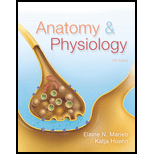
Roger is hit in the lower back by an errant baseball. What protects his kidneys from this mechanical trauma?
Case summary:
Roger got injured by an errant baseball which hit his lower back.
Characters in the case:
Roger
Adequate information:
Roger's lower back was injured.
To determine:
The lower body part at the back that protects kidneys from mechanical trauma.
Explanation of Solution
Kidneys are a pair of bean-shaped organs present on either side of the spine, right below the ribs behind the belly. This position is known as retro-peritoneal space. These are about 4-5 inches long and are connected to the ureters. Their major function is to purify blood and remove all the metabolic wastes out of the body. They also help in osmoregulation by maintaining the entry and exit of the electrolytes.
Lower part of the ribcage protects the kidneys from mechanical shock. Also, the adipose tissue present, known as perirenal fat capsule, also protects kidneys from mechanical injuries. This membranous sheath of fat covers the kidneys. These tissues act as shock absorbers and do not allow the injury to pass on to the kidneys.
Therefore, it can be concluded that perirenal fat capsules and skeletal ribcage help in protecting the kidneys from mechanical shock/injuries.
Want to see more full solutions like this?
Chapter 24 Solutions
Anatomy & Physiology
- Explain in a small summary how: What genetic information can be obtained from a Punnet square? What genetic information cannot be determined from a Punnet square? Why might a Punnet Square be beneficial to understanding genetics/inheritance?arrow_forwardIn a small summary write down:arrow_forwardNot part of a graded assignment, from a past midtermarrow_forward
- Noggin mutation: The mouse, one of the phenotypic consequences of Noggin mutationis mispatterning of the spinal cord, in the posterior region of the mouse embryo, suchthat in the hindlimb region the more ventral fates are lost, and the dorsal Pax3 domain isexpanded. (this experiment is not in the lectures).a. Hypothesis for why: What would be your hypothesis for why the ventral fatesare lost and dorsal fates expanded? Include in your answer the words notochord,BMP, SHH and either (or both of) surface ectoderm or lateral plate mesodermarrow_forwardNot part of a graded assignment, from a past midtermarrow_forwardNot part of a graded assignment, from a past midtermarrow_forward
 Anatomy & PhysiologyBiologyISBN:9781938168130Author:Kelly A. Young, James A. Wise, Peter DeSaix, Dean H. Kruse, Brandon Poe, Eddie Johnson, Jody E. Johnson, Oksana Korol, J. Gordon Betts, Mark WomblePublisher:OpenStax CollegeSurgical Tech For Surgical Tech Pos CareHealth & NutritionISBN:9781337648868Author:AssociationPublisher:Cengage
Anatomy & PhysiologyBiologyISBN:9781938168130Author:Kelly A. Young, James A. Wise, Peter DeSaix, Dean H. Kruse, Brandon Poe, Eddie Johnson, Jody E. Johnson, Oksana Korol, J. Gordon Betts, Mark WomblePublisher:OpenStax CollegeSurgical Tech For Surgical Tech Pos CareHealth & NutritionISBN:9781337648868Author:AssociationPublisher:Cengage Medical Terminology for Health Professions, Spira...Health & NutritionISBN:9781305634350Author:Ann Ehrlich, Carol L. Schroeder, Laura Ehrlich, Katrina A. SchroederPublisher:Cengage Learning
Medical Terminology for Health Professions, Spira...Health & NutritionISBN:9781305634350Author:Ann Ehrlich, Carol L. Schroeder, Laura Ehrlich, Katrina A. SchroederPublisher:Cengage Learning Human Physiology: From Cells to Systems (MindTap ...BiologyISBN:9781285866932Author:Lauralee SherwoodPublisher:Cengage Learning
Human Physiology: From Cells to Systems (MindTap ...BiologyISBN:9781285866932Author:Lauralee SherwoodPublisher:Cengage Learning





